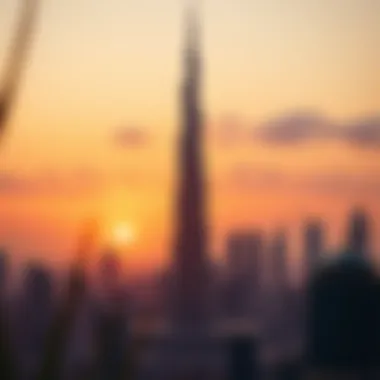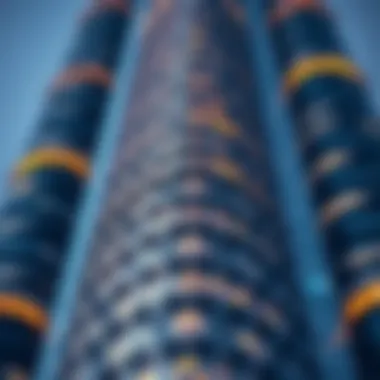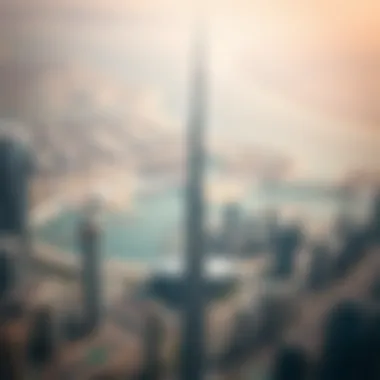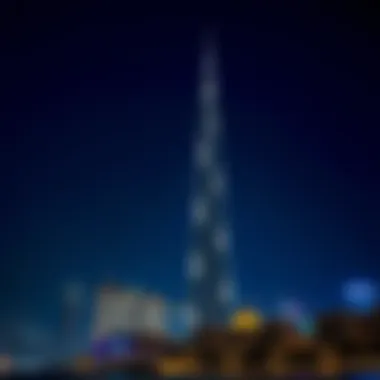Discovering the Architectural Wonder of Dubai's Tallest Tower


Intro
Dubai's skyline cuts a striking figure against the vast desert. In the heart of this astonishing city stands a tower that has captured imaginations worldwide. This is not just any tower; it's a statement of ambition, engineering excellence, and cultural significance. As investors, real estate professionals, and keen observers of urban development, understanding this landmark's multifaceted role will deepen one's appreciation of Dubai's evolution.
As we analyze this vertical marvel, we'll take a closer look at its architectural innovations, the market dynamics surrounding it, and its capacity to shape the urban landscape and boost tourism in the region. Unlike any typical building, this tower is a beacon that attracts global attention. It's a perfect example of how architecture can embody the spirit of a place.
In this article, we will unravel various sections, highlighting important investment opportunities that arise from the presence of such an outstanding structure, along with trends defining the current real estate climate in Dubai. Each piece contributes to a broader narrative about progress, investment potential, and cultural significance that resonates well beyond the glitter of the city itself.
Let's dive into the opportunities surrounding this architectural gem and see how it influences real estate markets, investment trends, and urban development.
Investment Opportunities
The presence of the tallest tower in Dubai doesn't just redefine the skyline; it creates a plethora of investment opportunities. Investors looking to tap into this vibrant real estate market can find exciting prospects that align with the city's growth ambitions. From luxury condos to business hubs, the areas surrounding the tower thrive, offering lucrative ventures.
Top Neighborhoods for Investment
Investors can't overlook the neighborhoods that flourish in proximity to this towering giant. Areas such as Downtown Dubai, which houses a mix of residential, commercial, and leisure, are at the forefront of this investment wave. Other notable neighborhoods include:
- Business Bay: An emerging hub for business and lifestyle, offering high-rises and waterfront apartments.
- Dubai Marina: Known for its luxurious lifestyle and vibrant culture, appealing to high-end renters and buyers.
- Jumeirah Lake Towers (JLT): A blend of residential and commercial sectors, ideal for middle-class investments.
These neighborhoods not only enrich the real estate landscape but also enhance Dubai's stature as a global city.
Upcoming Developments to Watch
With a rapid pace of development, several projects are set to rise in the coming years, promising to redefine the standards of living and working in Dubai. Some key projects include:
- Dubai Creek Tower: Once completed, it will compete directly with the tallest tower, making the area a new hotspot for tourism and business.
- The Dubai World Central: Positioned to facilitate the 2020 Expo legacy, it will enhance the logistical and operational dynamics of Dubai.
Keeping an eye on these developments is crucial for any investor aiming to capitalize on the growth in this vibrant market.
Market Trends
A deep dive into the real estate market dynamics in Dubai reveals a landscape that is both robust and evolving. Understanding current trends is essential for investors considering entry or expansion in this market.
Current Market Analysis
As of recent analyses, the Dubai real estate market has shown resilience despite global economic fluctuations. Key indicators include:
- Price Stability: While there has been variability, prime locations remain resilient.
- Increased Rental Yields: Rising demand for properties around the tallest tower suggests promising rental returns.
- International Interest: Foreign investments continue to pour into Dubai, bolstered by favorable regulations.
These elements illustrate a market that is not only surviving but adapting successfully to the current economic environment.
Future Projections and Trends
Looking ahead, the foresight in the Dubai real estate market is optimistic. Analysts project increasing property values, primarily driven by:
- Sustained Tourism Growth: The tower acts as a catalyst, drawing millions of visitors each year.
- Infrastructure Developments: Ongoing improvements in public transport and connectivity will enhance property appeal.
- Smart City Initiatives: As Dubai moves toward becoming a smart city, tech-friendly investments are likely to flourish.
With these factors in play, the future looks bright for investors in the Dubai real estate space. Recognizing and adapting to these trends will be vital for anyone intent on reaping the rewards of this dynamic market.
As the tallest tower in Dubai continues to shape the skyline, it also offers a foundation for investment growth, cultural appreciation, and architectural innovation.
In summary, exploring Dubai's tallest tower reveals much more than its height. From investment opportunities steeped in rich neighborhoods to market trends that indicate a promising future, this architectural wonder serves as an axis around which the urban narrative revolves. Consider engaging with the transformations it incites; both investors and stakeholders are ever reminded that the sky is indeed not the limit.
Prolusion to the Tallest Tower
The sheer presence of the tallest tower in Dubai isn't just a bragging right for the emirate; it symbolizes the relentless ambition and innovative spirit of its people. As we delve into the architectural phenomena that towers above the skyline, an understanding of its significance helps paint a broader portrait of this vibrant city. This introduction emphasizes key components such as the masterful design, pioneering construction techniques, and how this towering figure fits into the economic and cultural narrative of Dubai.
Overview of Dubai's Skyline
Dubai's skyline is nothing short of breathtaking. From the iconic Burj Khalifa to the striking curves of the Cactus Tower, each structure adds a unique brushstroke to the tapestry of its urban landscape. The blend of modernity and tradition in its architecture tells the story of a city that has embraced the future while cherishing its heritage.
As one gazes upwards, the towering silhouette of Burj Khalifa dominates the horizon, showcasing a continuous quest for excellence. The skyline reflects a remarkable balance between ambition and aesthetics, with structures designed not just to house inhabitants, but to inspire awe and create lasting memories for all who visit.


Key Highlights of Dubai's Skyline:
- Diversity of Designs: Architectural styles here are not just modern; inspiration comes from various cultures and epochs, offering something for every aesthetic taste.
- Cultural Significance: Each building is a reflection of the city’s evolution, marking critical moments in its short yet profound history.
- Technological Innovations: The skyline also showcases advancements in engineering, from sustainable practices to smart technologies that facilitate everyday life.
Historical Context
To truly appreciate the tallest tower, one must first explore the historical roots of its existence. Once a small fishing village, Dubai thrust into the global spotlight through its oil boom in the late 20th century. The city ventured into ambitious architectural projects that symbolized prosperity, resilience, and a desire to redefine a previously humble identity.
The decision to construct the tallest tower was not merely a bid for architectural supremacy; it was a statement of intent. A fusion of old-world charm and forward-thinking vision, the tower embodies the history of Dubai’s transformation into a regional powerhouse.
Important Historical Milestones:
- 1940s: Discovery of oil reshapes Dubai’s economic landscape.
- 2000s: A surge in construction projects introduces global architects to the emirate, seeking to leave their mark.
- 2010: The completion of Burj Khalifa heralds a new chapter, reinforcing Dubai's status on the world stage.
That backdrop of historical context becomes more than mere facts; it encapsulates an evolution that resonates deeply with local identity and aspirations. As the tallest tower stands tall, it invites reflections on growth, ambition, and the dreams of a nation.
Architectural Design
Architectural design is the backbone of any monumental structure, serving both aesthetic and functional purposes. In the case of the tallest tower in Dubai, the design encapsulates the city's forward-thinking mindset and its ambition to be a global leader in architecture and urban development. The architectural approach taken has not only created an iconic skyline piece but also introduced several essential elements that optimize energy use, enhance visitor experience, and establish a sense of place in a rapidly changing urban environment.
Inspiration Behind the Design
The inspiration for the tower's design draws from various sources, melding tradition with modernity. Architects looked at Islamic architecture, specifically the harmonious shapes, intricate patterns, and the spirit of reaching for the heavens often seen in historic mosques. Besides that, the structure mimics the local desert flower, the Hymenocallis, which resonates with the natural landscape of Dubai. This connection to local flora emphasizes the integration of nature into urban spaces, a vital aspect of contemporary architectural philosophy.
Using these influences, the design embodies not just a physical structure, but also a narrative that connects Dubai’s past and future. Its form, which rises gracefully into the sky, reflects the aspiration of the Emirati people and their commitment to innovation.
Key Architectural Features
The tower is a masterpiece of modern engineering with several striking features:
- Height and Structure: Standing at over 828 meters, the tower is designed to withstand strong winds and seismic activity, employing a unique buttressed core system for enhanced stability. This innovative structure allows for a slender ascent, maximizing usable space while minimizing material use.
- Facade: The exterior is clad in reflective glass and aluminum, forming a dazzling surface that changes color with the play of light throughout the day. This enhances the overall aesthetic and reduces energy consumption by reflecting solar heat.
- Lighting System: The dynamic lighting system used on the tower creates a spectacular display at night, showcasing not only its height but also the architectural features. The lights can be programmed to represent national celebrations, making the tower a canvas for civic identity.
"The design blends symbolism and function, a dance between beauty and utility, embodying the spirit of Dubai in every aspect."
- Landscape Integration: Surrounding the base, the landscape showcases lush greenery and water features, providing a serene contrast to the towering structure above. This integration not only improves the microclimate but also creates a welcoming environment for visitors.
- Sky Deck: Finally, the observation decks are positioned strategically to offer breathtaking views of both the city and the desert beyond. Visitors experience a sensory journey as they ascend, moving through different atmospheres that reflect the regions of Dubai.
These architectural features collectively elevate the tower beyond mere structure; they create an experience that engages visitors, honors cultural identity, and propels Dubai's image as a global hub of innovation and design.
Construction Journey
The construction journey of the tallest tower in Dubai stands as a testament to human ingenuity and ambition. It reflects a pivotal phase in Dubai's rapid transformation from a modest trading post to a global metropolis. Within the context of the tower's significance, this chronicle details every hurdle and triumph that shaped the landmark we see today.
Project Timeline
When it comes to ambitious projects like the tallest tower, timelines often become a blueprint for success. The construction kicked off in 2004, setting an ambitious goal to redefine the limits of architectural possibility and is worth noting that the process was meticulously planned. After breaking ground, the project escalated quickly. By 2007, significant structural work had already taken shape, with the core going vertical at an impressive pace. Notably, within just a few years, the tower had risen to a staggering height of over 800 meters, challenging the very notion of vertical architecture. Tracking milestones is crucial; each level completed not only brought the structure closer to completion but also attracted global attention.
"A tower goes beyond mere structure; it represents a vision, a dream brought to life."
Challenges Faced
It wasn’t all smooth sailing. The journey was fraught with challenges that tested the resolve of architects and builders alike. Extreme weather conditions often complicated construction schedules. High winds posed risks not only for the workers but also for the materials being hoisted to dizzying heights. Then, there were engineering challenges; as the building ascended, so did the complexity of its design. The need to ensure stability while pushing the limits of height meant revisiting foundational structures repeatedly. Moreover, adhering to safety standards in a skyscraper of such magnitude was another layer of complexity. The mantra throughout this phase was clear: adaptability in the face of adversity is what separates a simple project from an iconic landmark.
Innovative Techniques Used
Assembling this architectural feat necessitated pushing the envelope on construction technologies. Noteworthy was the use of high-strength concrete, enabling the tower to sustain immense load while remaining light enough for efficient construction. Additionally, personnel utilized a unique system known as the "jumping formwork" technique, allowing for rapid construction of the tower’s core. This method allowed the walls to rise swiftly without compromising stability, a win-win situation for the team. Technological innovations like drones were integrated for material monitoring, overseeing progress, and ensuring precision in the placement of elements — a rather novel approach in the construction industry at the time.
In summary, the construction journey of the tallest tower in Dubai is nothing short of extraordinary. It combines human spirit, innovative engineering solutions, and the relentless pursuit of excellence. As the upward climb continued, it not only represented a physical height but also a new having raised the bar for architectural capabilities worldwide.
Technological Integration
The construction of the tallest tower in Dubai isn't just a testament to architectural ambition; it also highlights the crucial role of technological integration in modern engineering. With a looming structure that redefines the skyline, every inch and element of this tower reflects cutting-edge technology designed for longevity, efficiency, and comfort. This section delves into the duo of sustainable practices and smart technologies that intertwine to elevate the tower's stature, serving not only as an architectural gem but also as a beacon of innovation.
Sustainable Building Practices
Sustainability isn't just a buzzword anymore; it has become the backbone of contemporary construction. The tallest tower in Dubai exemplifies this shift toward environmentally friendly building methods. Utilizing sustainable building practices means reducing waste and resource consumption while enhancing the comfort of its occupants.


One remarkable practice is the installation of energy-efficient systems that monitor and optimize energy consumption. For instance:
- Solar panels placed strategically around the building harness sunlight, significantly cutting down on energy costs.
- Rainwater harvesting systems collect and repurpose rainwater for non-potable uses, ensuring that the tower utilizes its surroundings wisely.
Moreover, materials like recycled steel and low-emission concrete were employed to minimize the carbon footprint during construction. Not only does this practice help the environment, but it also speaks volumes about Dubai’s commitment to sustainable urban development.
"In a rapidly urbanizing world, opting for sustainable practices is not just prudent; it's imperative."
Such initiatives position the tower as a leading example of how high-rise buildings can operate harmoniously within urban environments, pushing the envelope on what it means to build responsibly.
Smart Building Technologies
The introduction of smart building technologies inside the tallest tower in Dubai brings both luxury and practicality to the forefront. These technologies enhance the overall experience for occupants and visitors, making the building not just a place to live or work but a complete ecosystem of connectivity.
Key features in this domain include:
- Automated lighting systems that adapt to natural light levels, ensuring optimal illumination while conserving energy.
- Smart elevators that use algorithms to predict peak usage times, minimizing wait times and enhancing efficiency.
- Integrated security systems that utilize facial recognition and motion sensors to ensure safety without compromising ease of access.
Additionally, the building's management system integrates all these components into a unified interface. This interface allows property managers to monitor performance metrics in real-time, swiftly addressing issues as they arise.
The blend of sustainability and smart technologies in the tallest tower creates an environment that is not only advanced but also highly adaptable, setting a benchmark for future constructions around the globe.
Economic Impact
The economic influence of Dubai's tallest tower extends well beyond its impressive height and architectural grandeur. This prominent landmark plays a crucial role in shaping the financial landscape of the region, affecting not just local businesses but also international perceptions. At its core, the tower serves as a beacon of investment opportunities, drawing attention from around the globe.
Given Dubai's goal of becoming a major business hub, understanding the economic impact of the tower provides vital insights into its contributions to the local ecosystem. This architectural wonder is a catalyst for innovation, attracting financial investments and stimulating various sectors, including tourism, real estate, and commerce.
Contribution to Local Economy
The tallest tower in Dubai is more than just a sky-piercer; it's a lifeline for the local economy. An array of sectors benefits from its mere presence.
- Job Creation: During the construction phase alone, thousands of jobs were generated. From skilled labor to managerial roles, this project injected vitality into the local employment market.
- Tourism Revenue: With millions of visitors annually, the tower draws tourists eager to witness its iconic stature. Increased foot traffic means higher revenue for local businesses, hotels, and restaurants, substantially boosting the economy.
- Attraction for International Investment: The tower has acted as a magnet, attracting multinational corporations and investors looking to establish or expand their presence in Dubai. This influx cultivates a thriving economic environment.
In addition, the local government has seen increased tax revenues from the flourishing businesses surrounding the tower. The ripple effect of its economic contributions can be seen throughout the community.
Real Estate Market Dynamics
The tallest tower's impact on the real estate market cannot be underestimated. This structure has precipitated significant shifts in market dynamics, contributing various layers to the overarching real estate narrative.
- Property Values: The tower has heightened property values in its vicinity. Real estate around iconic landmarks tends to command higher prices, and this tower is no exception. Buyers see value in living close to such a prestigious structure.
- Commercial Developments: New commercial spaces sprout up like mushrooms after rain in the tower's shadow, including office spaces, retail, and hospitality venues. Investors are more likely to back projects in such a prime location, encouraging dynamic growth.
- Urban Development: The tower has spurred additional infrastructure development, leading to improvements in transport and public services which benefit the real estate market long-term.
"The tallest tower is not just an architectural achievement but a significant economic engine for Dubai, driving growth and investment."
For further reading on the economic aspects of the tallest tower in Dubai, check out articles on Britannica, Wikipedia, and forums like Reddit.
Consider these links for insights into investment trends in the UAE: UAE Government and Dubai Land Department for real estate information.
Cultural Significance
The tallest tower in Dubai transcends mere architectural prowess. It represents a blend of culture, ambition, and innovation, standing as a statement of what modern urban life can offer. By looking closely at its cultural significance, we can appreciate how this towering structure impacts not just the skyline but the very identity of Dubai.
Symbol of Modernity
The tower embodies the essence of modernity. In a city known for its rapid transformation, it serves as a beacon of progress, showcasing Dubai's aspirations on a global stage. The architectural style is not merely reflective of current trends, but it pushes boundaries, demonstrating what can be achieved when vision meets execution. Locals and visitors alike often find themselves gazing up in awe, recognizing the courage it took to create such a landmark.
Beyond its physical height, the tower stands tall as a symbol of Dubai's indomitable spirit. It emphasizes how a once barren desert landscape can evolve into a bustling metropolis. This transformation is crucial, not just for Dubai's identity, but also as an inspiration to other cities around the world. The tower thus symbolizes the potential within urban landscapes, encouraging cities to redefine themselves and embrace their modern personas.
Impact on Tourism
Tourism in Dubai owes a great deal to the allure of the tallest tower. It draws millions each year, where every corner, every view is rich with opportunity for memorable experiences. Visitors flock not only for its height, but also for the unique experiences it promises. From the observation deck, one can marvel at views stretching for miles, capturing the magnificence of Dubai sprawled below.
This influx of tourists fuels the local economy, creating jobs and fostering a culture of hospitality. Restaurants, hotels, and shops flourish around it, from high-end boutiques to traditional bazaars, enhancing the cultural tapestry of the city. In many ways, the tower acts as the gateway to Dubai, giving tourists a taste of its vibrant life.
"A city with a towering symbol echoes stories of hope and resilience, welcoming people to discover its riches and charm."


Moreover, the tower serves as a backdrop for events and celebrations throughout the year, attracting not just visitors but also international media coverage. Festivals, light shows, and cultural events bring the community together, adding layers to the cultural significance of both the tower and the city.
This interconnectedness underscores the idea that while the tower may stand as the pinnacle of engineering, it is the cultural experiences surrounding it that truly elevate its significance in the eyes of the world.
In summary, the tallest tower in Dubai goes beyond being a landmark; it forms part of the cultural fabric of the city. Its role as a symbol of modernity combined with its significant impact on tourism demonstrates how architectural wonders can profoundly affect cities, making them vibrant, prosperous places filled with endless possibilities.
Visitor Experience
The visitor experience at the tallest tower in Dubai is central to its identity as a global icon. This landmark is not just an architectural feat but also a hub of activity designed to offer a comprehensive experience to all who step through its doors. The blend of sightseeing, dining, and interactive exhibits ensures that visitors leave with lasting memories.
Observation Deck and Facilities
At the heart of the tower’s allure is its observation deck, located high above the bustling city. Standing at approximately 148 floors, this deck offers breathtaking views that stretch far beyond the horizon. The floor-to-ceiling windows provide an unparalleled, 360-degree perspective of Dubai’s skyline. Visitors are often left speechless, gazing down at the Marina, the Palms, and even the desert that surrounds this urban hub.
But it's not just the views that impress. The facilities at the observation deck include state-of-the-art telescopes, information screens, and even interactive displays that narrate the history and development of Dubai. These features enrich the visit, turning a simple observation into an educational journey.
Moreover, the seating arrangements allow visitors to relax and take in the sights, making it a perfect spot for social media enthusiasts eager to capture the moment. Amenities such as clean restrooms, refreshments, and informative guides cater to diverse needs, ensuring that everyone’s experience is comfortable and informative.
Events and Activities
The tower doesn't stop with its stunning visuals; it also hosts a range of events and activities, further enhancing its reputation as a must-visit destination. Regular workshops, art exhibitions, and cultural events utilize the breathtaking setting to engage both locals and tourists. These activities reflect Dubai’s commitment to being a cultural melting pot.
In addition to scheduled events, visitors can also experience seasonal festivities. For example, during the New Year, the tower becomes the centerpiece of one of the world’s most extravagant firework displays. The festivities draw thousands, showing how the tower's location can transform the visitor experience into something truly epic.
"The height of luxury is not just the altitude but the altitude of experience."
Much like a fine dining restaurant that offers a tasting menu, the tower provides a buffet of experiences that cater to various interests. From high tea sessions on the observation deck to live performances, the activities available make each visit unique.
The combination of stunning views, educational features, and a variety of engaging activities makes the visitor experience at the tallest tower in Dubai truly unforgettable. The tower stands not only as an architectural marvel but also as a dynamic arena for culture and engagement.
Future Prospects
The future of the tallest tower is not merely a question of height or design; it's a landscape of possibilities. As the architectural marvel rises into the sky, it offers a unique fusion of potential developments that can shape Dubai's future. This section will delve into the importance of these prospects for investors, agents, and property managers, highlighting advantages and considerations for the forthcoming years.
Potential Developments
As Dubai's rapidly changing skyline continues to evolve, the tallest tower must adapt and incorporate new developments. Here are several possibilities:
- Mixed-Use Spaces: As urban planning pivots toward multifunctional spaces, the tower could evolve to house offices, hotels, and residential units all under one roof. This would not only cater to a diverse clientele but also promote a city lifestyle where everything is within reach.
- Technological Enhancements: Smart technologies can be seamlessly integrated into operations. Systems that optimize energy use, waste management, and building maintenance can be implemented. For example, utilizing IoT sensors to monitor building systems could lead to increased efficiency and reduced operating costs.
- Vertical Green Spaces: Integrating parks or gardens at different levels could enhance both the aesthetics and environmental sustainability of the structure. Providing greenery amidst urban life can improve air quality and offer residents and visitors a breather from the bustling city below.
- Global Partnerships: Collaborations with international firms could spearhead new projects or innovative designs that keep attracting global interest. As the world increasingly leans towards sustainable development, forming alliances that emphasize eco-friendly practices in construction and operation is paramount.
Sustaining Relevance in Global Landscape
In a world where the demand for skyscrapers is high, sustaining relevance amidst a global field is crucial. Here are essential points to consider:
- Continued Innovation: As trends shift, investors must keep an eye on innovations in architecture and construction. Staying ahead involves not just following trends but setting them. For instance, consider incorporating renewable energy sources like solar panels or wind turbines within the tower's design to reduce its carbon footprint.
- Cultural Engagement: The tallest tower’s image can evolve through cultural initiatives. Hosting art exhibitions, cultural festivals, or collaborative events with local artists can enhance community engagement and attract diverse visitors. Creating a platform for cultural exchange solidifies its role in Dubai beyond mere tourism.
- Adaptable Spaces: The agility of the tower itself will play a determining role in its relevance. As markets fluctuate, having adaptable design elements, which allow for various functions over time, becomes increasingly valuable. This ensures that it can serve different needs, whether for work, leisure, or even emergencies.
"To maintain a competitive edge, the tallest tower must not only be a feat of engineering but also a beacon of sustainability and innovation."
The tower stands as a vital part of Dubai's identity and its future direction. Economic shifts, coupled with technological advancements, will ensure it remains a cornerstone in shaping the cityscape for years to come.
Epilogue
In summing up the exploration of the tallest tower in Dubai, it becomes clear that this structure is more than just a physical landmark; it is a symbol of human ingenuity and ambition. Its significance extends into various domains, from economic to cultural, each layer adding depth to its identity.
Recap of Key Insights
Reflecting on the journey through this article:
- Architectural Marvel: The tower stands not only as a tall building but as a testament to modern architectural tactics. Its design draws from various inspirations, intertwining elements of traditional Islamic architecture with contemporary aesthetics.
- Construction Challenges: The journey to completion was fraught with challenges including extreme weather conditions and the complexity of the design. Yet through innovative techniques like advanced concrete technology, the builders overcame significant hurdles.
- Economic Contributions: Beyond serving as a tourist magnet, the tower has invigorated the local economy. Its presence has reshaped the Dubai real estate market, drawing investments and generating jobs.
- Cultural Impact: The tower serves as a beacon of hope and progress, embodying the spirit of what Dubai strives to achieve. It has become an icon, influencing tourism patterns and establishing Dubai as a must-visit global destination.
These insights underscore the multi-faceted importance of the tallest tower and its ramifications on Dubai and beyond.
Implications for Dubai's Urban Future
The towering structure not only shapes the skyline but also sets a precedent for future urban developments in the region.
- Inspiring Innovation: As a manifestation of advanced engineering prowess, it encourages local and international architects and builders to raise the bar higher, quite literally. This could lead to more groundbreaking designs that redefine urban living.
- Environmental Considerations: With growing awareness about sustainable practices, future constructions may take cues from this tower's integration of smart technologies and eco-friendly solutions, promoting a greener footprint.
- Real Estate Evolution: The ongoing success of the tower also suggests a continued influx of investment in surrounding areas. New residential and commercial developments may emerge as property values increase, benefiting developers and investors alike.
- Cultural Exchange: The tower’s role in drawing global tourists hints at future opportunities for cultural exchange initiatives, turning Dubai into a vibrant hub for international dialogue and interaction.
Overall, the implications of this iconic tower stretch into various sectors, prompting thoughtful considerations about Dubai's urban future and global standing.
"From dreams to reality, this tower represents not just a building, but the essence of progress and ambition guiding Dubai into the future."



